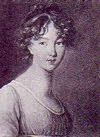
The Wine Shop by Phiz (Halbot K. Browne (1815-1882)), A Tale of Two Cities, Book II, Chapter XVI [Still Knitting],(1859), by Charles Dickens, (1812-1870)
"No crowd was about the door; no people were discernible at any of the many windows; not even a chance passerby was in the street. An unnatural silence and desertion reigned there. Only one soul was to be seen, and that was Madame Defarge--who leaned against the door-post, knitting, and saw nothing." (Book I, Chapter VI)
Once again, we have the knitter who apparently sees (or hears) nothing. Twice over as the following paragraph ends with the same nine words. Leaning against a door which equals fading into the background is often how knitters are perceived. I have mentioned Miss Marple before and here is another, seemingly, uninvolved knitter, lost in her work. Phiz's rendition, too, portrays a woman looking at her knitting although the accompanying text in the chapter describes Madame Defarge receiving compliments about her knitting, discussing it and composedly "looking at him with a smile while her fingers moved nimbly," all in the midst of a situation of espionage and she never drops a stitch or loses count of the chilling project on her needles.
More importantly, the knitting never stops in this novel, features in the titles of three of the chapters but is symbolic in far too many ways to discuss in a short post like this one. Perhaps another time as now I have to get back to my knitting!


3 comments:
what a wonderful essay! I love your writing and found myself thinking about my own knitting and observation as I fade into the background of my friends' gatherings....
Thank you, Unraveling Sophia! I enjoy your blog, too.
Sometimes it is fun to fade into the background, don't you know (mischievious cackle, here!) :)
I had forgotten about Madame DeFarge. Books with knitters - my favorite combination.
Post a Comment